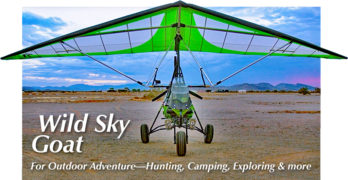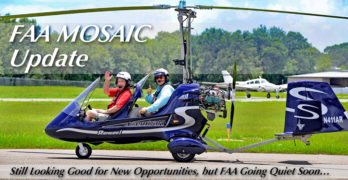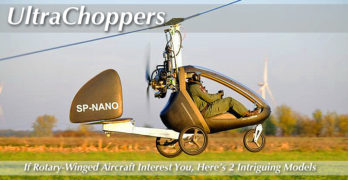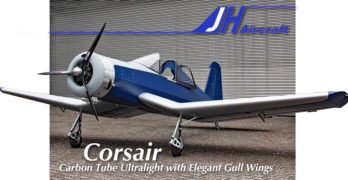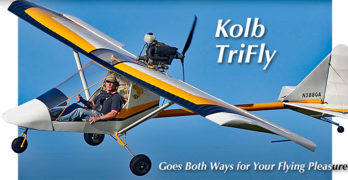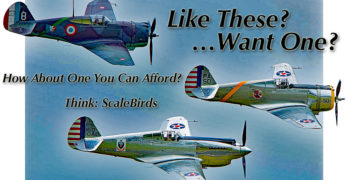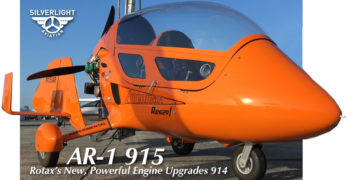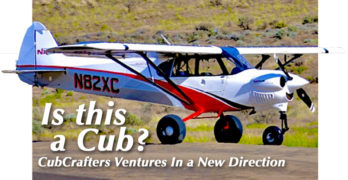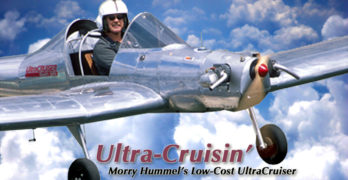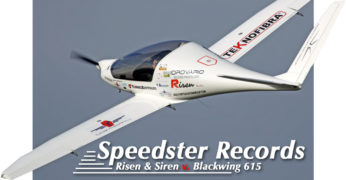If you flew better than 9,000 hours solely to give trike instruction, you would tend to develop ideas about how an aircraft can better fit the type of flying lessons you want to give. That’s exactly what Wild Sky owner Denny Reed reports.
Denny has an enviable position to some. Imagine any fixed wing instructor saying, “I wish the aircraft would do some operations differently for my teaching. I can’t find one that exactly matches what I seek, so, you know what? I’ll just design what I want.”
Yeah, sure. Most of us never have that chance. Instead, we learn to adapt to the aircraft. As an example, what if you wanted the throttle in a different place, or any number of possible changes.
In a long career that has included talking to CFIs from around the world, I have never met a fixed wing flight instructor who set about making the airplane he truly wanted.
Search Results for : Flight Design
Not finding exactly what you expected? Try our advanced search option.
Select a manufacturer to go straight to all our content about that manufacturer.
Select an aircraft model to go straight to all our content about that model.
FAA’s New Light-Sport Aircraft Regulation — Progress Update for July 2020
The end is near! Or, is it?
The reference is to the long-running effort to revise the FAA regulation affecting Light-Sport Aircraft. The new ruleset has been discussed back into 2017 and started to take shape in early 2019. Almost two years later, what is the status?
I have reported on this earlier: May 2019 • July 2019 • January 2020 • and April 2020. For additional detail, go back and check those articles. In this newest report — based on LAMA‘s work with the aviation regulator — I will describe the newest development although a short review of the history is useful.
When I ask if the end is near, I mean to ponder if FAA is done with their work. Even some in industry believe FAA is about to release what’s call an NPRM: Notice of Proposed Rule Making.
UltraChoppers — Exploring Two Light Rotary-Winged Aircraft: 1 Helo + 1 Gyro
➡️ This article was UPDATED on July 31, 2020 with additional information — see after video…
Some pilots love to whirl their wings over their heads. Many others like the idea of rotary flight — offering short takeoffs and landings plus ease of operation in windier conditions. A majority have not (yet) acted on their interest but perhaps they are waiting for the right aircraft, maybe one of these.
One is a very light coaxial helicopter from Russia. The other is a single place gyroplane from Poland.
Micron-3 Coaxial Helicopter
Have a glance at the RD Heli’s Micron-3 ultralight helicopter. This is like no other ultralight helicopter I’ve ever seen, although the idea of coaxial is not new.
History suggests coaxial rotors originated with Mikhail Lomonosov a very long time ago, according to Wikipedia. Over the years, many helicopter models have emerged but none so compact as Micron-3
Coaxial rotors are a pair of helicopter rotors mounted one above the other driven by concentric driveshafts, with the same axis of rotation, but turning in opposite directions (contra-rotating; see graphic).
All Carbon Fiber (Structure) Part 103 Ultralight Aircraft — Corsair is Coming to America
Most ultralight aircraft (officially: “ultralight vehicles”) are rather simple constructions. They must be to stay within the tight constraints of a 254-pound maximum empty weight.*
That’s not a negative comment about them. Actually, it’s the opposite.
To build a flying airplane that weighs less than the engine alone on a Light-Sport Aircraft, a designer has to be unusually clever.
All aircraft are constrained in weight by the laws of physics. Ultralights are further constrained by regulation.
A key way to keep an aircraft light is to keep it simple. Indeed most 103 ultralights are quite basic. However, as years passed some engineers have found intriguing solutions. I recently wrote about the composite Swan. Why not one using extensive carbon fiber?
Carbon Corsair
German developer Jörg Hollmann took a different approach, one that consumed a few years of effort.
He wanted an aircraft that resembled the famous World War II F4U Corsair fighter.
Try and Fly TriFly — Kolb’s Wonderful Single Seat Light Aircraft Goes Both Ways
Some pilots are wary of taildraggers. This is hardly surprising since only tricycle-gear aircraft have been used in primary flight instruction dating back into the 1970s. Most pilot have no experience with taildraggers but nearly all have heard of the dreaded ground-loop tendency such gear configuration can allow.
Indeed, when investigating insurance for a taildragger, you will have to prove you have some experience or get training from a suitably-experienced instructor — and you won’t find many able to help you.
How about if an aircraft went both ways? What if an affordable aircraft allowed you to fly with tricycle gear but permitted you to practice your taildragger technique yet still use the nosewheel’s self-straightening capability if you start to get a little “sideways” (literally or figuratively)?
Kolb Aircraft has an answer.
Kolb TriFly
Producers of Part 103 aircraft, such as Kolb Aircraft report consistently strong business for the last few years.
Vintage Light Kit Aircraft Heaven — Checking out ScaleBirds’ Curtis P-36 with 5-Cylinder Engine
ScaleBirds is not your run-of-the-mill kit aircraft company. In truth, all kit builders are amazing to me.
People who labor for years to design an aircraft, craft methods for making the constituent parts, assemble it all, work out bugs in construction, fly the aircraft, then smooth any rough edges of its flight qualities, start producing kit components — and the manual it will take for a non-expert to build the kit (perhaps the hardest task) — and finally, start the effort of telling people about the airplane, market it, sell it — and the big one — try to turn a profit for doing all the preceding. Any way you cut it, birthing a new design is an immense project.
Sam Watrous, his son Scott, and their merry band of (mostly volunteer) ScaleBirders are not merely doing all the above. They are emulating vintage American military designs in reduced scale and trying to get the details right so the kit versions look as much as possible like the originals.
American Ranger AR1 Gyroplane Embraces Rotax 915iS Power
You can call modern gyroplanes “wanna-be” helicopters if you want but that might miss a few important points.
First, a gyroplane can be flown by a Sport Pilot. Other than Part 103 ultralight version, a helicopter requires a higher certificate and that means a medical, at least BasicMed.
LAMA believes gyroplanes will be included in FAA’s revised LSA regulation from what is known at this time. That means they’ll be available ready-to-fly and prices are so much less than conventional helicopters that it’s not even comparable. Comparing the most deluxe fully-built gyroplane to even a used helicopter is a world apart. Finally, maintenance of a gyroplane is dramatically less than any helicopter.
Despite those differences, gyroplanes enjoy some of the same performance capabilities of a helicopter — other than vertical launch. Gyroplanes also work unusually well in wind conditions that might ground most other aircraft.
No wonder gyroplanes have enjoyed a huge run in space-tight European countries and have been growing steadily in the USA.
WHAT?! A Cub Dragging its Nose Rather than its Tail? CubCrafters’ Newest Entry…
What on Earth is the world coming to…?! A Cub with a nose wheel? Has the aviation world gone mad?
No, of course not. Admittedly, though, a nosedragger is certainly not what most pilots think when they envision a Cub.
Leading manufacturer CubCrafters has explored many corners of the Cub world, filling niche after niche in fulfilling resilient demand for this popular airplane design. (Note that I keep calling this aircraft a “Cub,” instead of “Cubalike” because the Washington company actually owns that name after acquiring it from Piper some time back.)
Cub Wonderment
“Following a year-long public market survey,” CubCrafters announced, “[we have] officially decided to [start efforts to] certify and offer a nosewheel option for our flagship Part 23 certified aircraft, the CC-19 XCub.” This is not an Light-Sport Aircraft entry, however, the model remains easily within the coverage area this website pursues.
“Putting a nosewheel on a modern Cub type aircraft certainly surprised some people,” noted CubCrafters’ VP of Sales & Marketing, Brad Damm.
One More Part 103 Ultralight Aircraft: UltraCruiser by Hummel Aviation
In April, lots of readers were clearly pleased with the “Vintage Ultralights” series. Thanks to our cooperation with Videoman Dave and his popular YouTube channel, we were able to present ten well-proven aircraft that could be purchased for well under $10,000 …assuming you could find one that met your needs and passed a careful inspection.
Bargains may not be the easiest aircraft to find and buy yet the effort can pay off with a flying machine allowed by your budget and which can bring a smile to your face. That seems worth the search.
However, our 10-aircraft review was not exhaustive. Even more choices are available! Some very modestly priced aircraft — Legal Eagle is one of several (yes, several!) possibilities — are available as a new aircraft purchases for a fairly small amount of money. Another is Hummel Aviation’s UltraCruiser (see lots of links below).
Racing Risen — A “Pandora’s Box” (and Lesson) About Speed Records in Light Aircraft
In our strongest month ever, April 2020, our biggest story was about the Swedish Blackwing “Speed Monster.” Pilots almost universally admire a beautiful and fast aircraft. Blackwing won hearts …and perhaps some orders for the Scanadanavian manufacturer.
Blackwing edged out Risen with its record flight, prompting a representative of Porto Aviation Group to provide a deeper perspective. Many years ago as an active hang glider pilot, I found the records-keeping body, FAI, to be very strict and formal in how it administered world record claims.
Siren or Risen
Whatever the Name; It’s Fast
One of my most popular videos (with well over a half million views and hundreds of comments) is an interview I did with Alberto Porto, developer of Risen. It was 2015 and he had just introduced his speedster He said it would set records and it turns out he knew what he was saying.
- « Previous Page
- 1
- …
- 61
- 62
- 63
- 64
- 65
- …
- 148
- Next Page »


